-

人教版新目标初中英语八年级上册I’m more outgoing than my sister教案2篇
1 交通工具的比较此活动为小组活动。学生通过讨论找出到达某一城市可乘坐的各种交通工具,并选择最佳出行方式。Teacher:We’re going to Shanghai. How many ways can we use to get there? Yes, there are four ways: by bus, by plane, by train, by ship. Please discuss how you are going to get there.操作建议:(1)学生以小组为单位展开活动,谈论本组所选择的交通工具。(2)各组选代表向全班汇报,阐述本组所选择的交通工具的利和弊。完成任务所需要的语言结构:We can go there by ship. It’s more comfortable and cheaper than any other transportation.We can go there by bus. It’s cheaper but it takes longer time.2 哪个城市更合适?此活动具有挑战性。假设中国要举行2014年世界杯足球赛,分别从历史,人文,天气等方面对各城市(北京,大连,上海,昆明)进行比较,选择最佳举办城市。T: Imagine China is holding the 2014 FIFA World Cup. Which city do you think is the best for the World Cup, Beijing, Dalian, Shanghai or Kunming? Let’s work in groups. If you choose Beijing, please join the Team Red. If you chose Dalian, please join the Team White. If you choose Shanghai, please join the Team Blue. If you choose Kunming, please join the Team Green. Please show us its advantages. Then let’s see which team will win.

人教版新目标初中英语八年级下册It’s a nice day, isn’t it教案2篇
"Hello! Welcome to English class! Introduce yourself. Meet your new classmates." That's what the teacher says. What do you say? "Oh no!" It can be difficult talking to new people. But it can be fun, and you can make friends. How do you do it? Make small talk. Small talk is polite conversation. "Wang Nan is a great pingpang player, isn't she?" "I'd love to meet her, wouldn't you?" "It's been raining a lot, hasn't it?" Tag questions are a form of polite speech. To make small talk successfully, you should know how to make them. You should also know what topics to talk about. Try to learn this unit carefully. The next time you're in English class, you'll find out. Making small talk's easy, isn't it? (“你好!欢迎你!请做一下自我介绍。认识一下你的新同学。”通常在课上老师会这样说。你会说什么呢?“噢,不!”与陌生人谈话太困难了。但是这也很有意思,并且你还能交到朋友。你该怎么做呢?闲聊。闲聊指得是礼貌的对话。“王楠是一个很棒的乒乓球运动员,不是吗?”“我希望自己能认识她,你呢?“今年的雨水很多,不是吗?”反意疑问句是一种礼貌用语。为了使得谈话成功,你应该知道怎样去进行闲聊。你还应该知道与不同的人该谈论什么样的话题。认真的学习这个单元吧,下次在英语课上,你会发现与大家展开谈话是一件很容易的事情,不信我们来试试。)

人教版新目标初中英语八年级下册He said I was hard-working教案2篇
This activity introduces some new vocabulary and provide oral practice using the target language.Task 1 . Ask four students to stand in front of the class, and the teacher asks them the following questions as a reporter.1.What are you going to do when you grow up?2.What are you going to do next week?3.What are going to do after school?The students will give different answers, then ask a good student to report what they said.I am going to e a doctor.What did she say?----------She said she was going to be a doctor.I am going to have a party on Friday night.What did he say?-------He said he was going to have a party on Friday night.I am going to do my homework.What did she say ?------ She said she was going to do her homework.I am going home after school.What did she say?-----She said she was going home after school.Say In this unit we are going to learn to use words like to report what someone said.Task 2. Read the instructions. Then ask a student to read the four questions. And write the words on the Bb. Explain what soap opera is.Task 3. Ask the students to Look at the pictures, point out the TV screens in the picture. Ask one girl to read what Marcia said.What did Marcia say? She said She said she was having a surprise party for Lana on Friday night. Repeat the other pictures in the same way.Activity3. Listen and number the pictures in activity 1a.

人教版新目标初中英语八年级下册How long have you been collecting shells教案2篇
Step Ⅱ Show the new words on the screen and teach the new words. Read the new words to students and ask them to repeat.Step Ⅲ 3aThis activity introduces new vocabulary and provides reading practice using the target language.In this activity first look at the four pictures.T: What can you see in the pictures?Ss: Four snow globes.T: Right. There are four snow globes in the pictures. And what are they?Ss: They are a monster, two polar bears, two penguins and a birthday cake.Write these words on the blackboard: snow globe; monster; polar bear; penguin and birthday cake. Read them to the class and ask students to repeat each one. Make sure students understand each word.Use a computer to show the E-mail message on the screen and read the message to students.Get students to read the e-mail on their own, and then draw lines connecting each snow globe and its description.Correct the answers.AnswersA line should connect each snow globe picture with the words that describe it in the letter.Step Ⅳ 3bThis activity provides writing practice using the target language.First review Activity 2a on Page 47.Then ask students to complete the message according to Activity 2a.Some partial sentences are given to students. Write about one person's collection.When students work, walk around the room checking the progress and offering help as needed.When they finish, ask some students to read their messages to the class.

人教版新目标初中英语九年级上册Teenagers should be allowed to choose their own clothes教案2篇
Step 1 Greeting Greet the class and check the homeworkStep 2 A duty report The S on duty gives a report on the rules in his home and lead in 3a “Sun Fei’s and Wu Yu’s rules” Step 3 ReadingSs read the conversation and write the two girls’ rules in the chart. Check the answers.Get Ss to read after the tape and then read aloud by themselves. Then, T explains the language points.Step 4 Pairwork 3bRole play. Use the information in chart to practice with the conversation in 3a covered. They can look at the sample conversation in the right box.Step 5 Task 2 “Who’s the best reporter?”Make a survey by asking any 5 students the questions in the chart in activity 4. Then give out a report about it. See who is the best reporter? And the best reporter will get a nice ball-pen.Step 6 Summary and homework:Write out the report in your exercise-books.Period ThreeStep 1 Greeting and a duty reportThe S gives a duty report talking about his experience of being late for school. Lead in the question “Do you ever get to school late? How often do you get to school late? Always, usually, sometimes, or never?Step 2 1a Get Ss to finish writing.Step 3 Pairwork 1b Get Ss to talk about their answers with their partners using the sample conversation in the box on the right.Step 4 Listening practice2a Lead-in: What will happen if you get to school late? What about Peter? Let’s listen to a conversation between Peter and his father. Get Ss to finish 2a (As usual, for the first time, Ss only listen.) Check the answers.

人教版新目标初中英语九年级上册How do you study for a test教案2篇
内容提示本单元主要内容是学会利用verb十by/with gerund表示方式方法来讨论学习英语的策略,认识自己在学习方面的长处和不足。初步了解现在完成时的结构和用法。现在完成时由助动词have/has+动词的过去分词构成,主要表示过去发生的某一动作对现在仍有影响或造成的后果,常与already,yet,just,ever,never等副词连用。教学目标一、学习目标(Language Goal) 1. Talk about how to study . 学会讨论各种学习方法和策略。2. Find out your suitable learning methods. 找出适合自己的学习方法。 二、语言结构(Language Structures) 1. Verb + by with gerund by+动名词短语 表示“通过…途径,方法” 2. How questions have引导的特殊疑问句 三、目标语言(Target Language) 1. How do you study for tests ? 你是怎样准备考试的?Well , I study by working with my classmates. 哦,我和同学们一起学习。2. Have you ever studied with a group ? 你曾经参加过学习小组吗?Yes , I have . I’ve learned a lot that way . 是的,参加过。通过这种方式我学了许多。

人教版新目标初中英语九年级上册Where would you like to visit教案2篇
The First PeriodⅠ.Teaching Aims and DemandsKnowledge Objects(1) Key Vocabularytiring, educational, fascinating, thrilling, peaceful, exotic, trek, jungle, take it easy, explore, historic, site(2) Target LanguageWhere would you like to go on vacation?I’d like to trek through the jungle, because I like exciting vacations.2. Ability Objects(1)Train students to talk about places they would like to visit with the target language.(2)Train students to describe vacations with different adjectives.(3)Train students' listening skill.3. Moral Object,It′s more interesting to go on vacating somewhere instead of staying at home.Ⅱ. Teaching Key Points1. Key Vocabularytiring, educational, fascinating, thrilling, peaceful, exotic, trek, jungle, take it easy, explore, historic, site2. Target LanguageTalk about different places with the target language.Ⅲ. Teaching Difficult Points1. Describe vacations with different adjectives.2. Talk about different places with the target language.Ⅳ. Teaching Methods1. Teaching by illumination2. Teaching by doing chain drills3. Teaching by pairworkⅤ. Teaching Aids1. A tape recorder2. Some pictures of different places with famous views

人教版新目标初中英语七年级下册How was your weekend教案2篇
Teaching Goal:1. General aims:Talk about recent past events2. Particular aims:A. Language Focus.Talk about recent past events and think of the past events.B. Language goalsHow was….?It was …What did …do over the weekend?C. Language structures:(1). How was your weekend? I was great. Pay attention to no form.(2). What did you do over the weekend? I played soccer. We went to the beach.D. Useful words and phrases:Words: was, did, went, beach, over, project, test, wasn’t, false, number, geography, spend, week, most, mixture, their, had, little, cook, read, saw, change, everyone, sit, sat, no, anythingPhrases: did one’s homework, played soccer, cleaned my room, went to the beach, played tennis, went to the movies, on Saturday morning, over the weekend, cook … for, what about, do some reading, have a party, talk show, go shoppingE. Grammar language:Present simple past tenseRegular and irregular verbsF. Learning strategies:Tour and holidaysG. Interdiscipinary:H. Emotion and manner:Teaching time: 5 periodsTeaching procedures:Period One教学步骤、时间 教师活动 学生活动 媒体应用Step 1Free talk 3’ Ask some questions like:Who’s on duty today?What’s the weather like? Answer and talk about something.让同学们回答下列问题1. Do you like weekend? (Let some students answer)It takes them three minutes to talk about the question.2. Why do you like weekend? (let the students answer) Most of the students like the weekend此时教师用汉语问:“在周末期间问你干了什么?这句话用英语这么回答?Let the students guess.At last the teacher give them right answer3. What did you do over the weekend?(板书、学习)
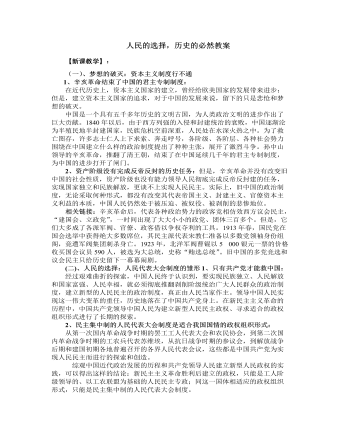
人教版高中政治选修3人民的选择,历史的必然教案
(三)、历史的必然:人民代表大会制度的确立1、《中国人民政治协商会议共同纲领》作为临时宪法规定我国根本政治制度是人民代表大会制度。新中国的成立,标志着亿万中国人民真正成为国家、社会和自己命运的主人。此前召开的中国人民政治协商会议第一届全体会议,为建立新型国家政权发挥了重大作用,会议通过的《中国人民政治协商会议共同纲领》具有临时宪法的地位,为全国人民代表大会制度的建立奠定了法律基础。共同纲领规定:中华人民共和国的国家政权属于人民,人民行使国家权力的机关为各级人民代表大会和各级人民政府。2、人民代表大会制度在我国正式建立起来的标志:1954年9月15日,第一届全国人民代表大会第一次会议在北京召开,会议通过了《中华人民共和国宪法》,标志着人民代表大会制度在我国正式建立起来。
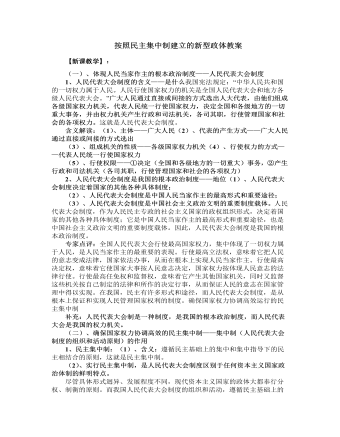
人教版高中政治选修3按照民主集中制建立的新型政体教案
◇本框题小结:◇3个体现:即人民代表大会制度是我国的根本政治制度的3个体现(1)、人民代表大会制度决定着国家的其他各种具体制度;(2)、人民代表大会制度是中国人民当家作主的最高形式和重要途径;(3)、人民代表大会制度是中国社会主义政治文明的重要制度载体。◇3个表现:即民主集中制确保国家权力协调高效的表现:(1)、从人民代表大会和人民的关系来看①各级人民代表受选民和原选举单位的监督,选民或选举单位有权罢免自己选举出的代表;②各级人民代表大会代表人民统一行使国家权力(2)、从人民代表大会与其他国家机关的关系来看①其他国家机关都由人民代表大会产生,对它负责、受它监督;②在人民代表大会统一行使国家权力的前提下,其他国家机关依照法定分工依法行使各自的职权。(3)、从中央和地方的关系来看①地方必须服从中央;②在保证中央统一领导的同时,必须考虑地方特殊利益,充分发挥地方的主动性和积极性。
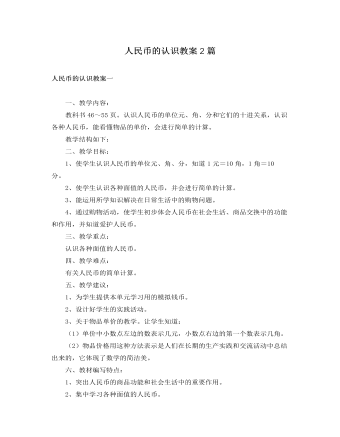
人教版新课标小学数学一年级下册人民币的认识教案2篇
出示例6挂图。教师试问:谁知道0.50元是几角?2.00元是几角?你是怎么知道?以元为单位小数点左边是几就是几元,右边第一位是几就是几角,右边第二位是几就是几分。1.20元是1元2角。35.90元是35元9角。(这部分知识学生知道它表示几元几角就可以了,至于1.20元是个什么数,怎么读、写不需要学生掌握)3、教学例7。(1) 课件演示例7第一小题。教师:0.5元是几角?(5角)0.80元是几角?(8角)学生回答。5角+8角是几角?(5角+8角=13角教师板书)教师问:多少角是1元?13角里面拿出10角还剩多少角?(3角)所以13角等于1元3角。教师板书:5角+8角=13角=1元3角。(2)例7第二小题(课件演示,提出问题:我买这两个气球要多少钱)学生尝试完成,然后提问:你是怎么想的?教师强调:元、角计算,只有在相同单位的情况下,才能相加。
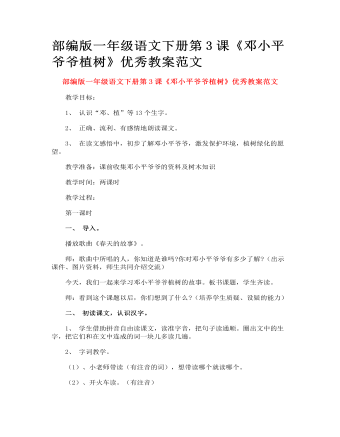
部编版一年级语文下册第3课《邓小平爷爷植树》优秀教案范文
读文感悟。 1、出示:邓小平爷爷( )地种柏树。 师:同学们带着这个问题仔细读课文,用“——”划出有关句子。然后想一想,“( )”里填什么词比较恰当。 2、生自由读课文,边读边划。 3、 全班汇报交流。 师:你认为邓小平爷爷( )地种柏树,从哪些地方体现出来? (以读为主,引导学生学会读课文,尊重学生个性化的理解。“( )”里可填“起劲、仔细、认真、一丝不苟、小心”等等,随机进行读文,结合语言文字训练,体会邓小平爷爷积极为祖国绿化作贡献的精神。) (如:找出邓小平爷爷种树的动作词“挖、挑选、移、填、站在、扶正”,同桌伙伴,一人做动作,一人口述植树过程。“移”字可换“放”字比较理解。) 4、 四人小组讨论:邓小平爷爷为什么种树?他是怎么想的? (结合课前收集的邓小平爷爷的资料理解,体会邓小平爷爷一心为国之心,激发学生参与绿化的热情。)
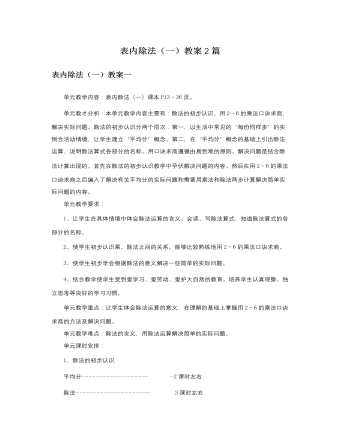
人教版新课标小学数学二年级下册表内除法(一)教案2篇
教后反思本节课给学生创设了良好的活动空间,把学生实际生活中听说过的见到的平均分现象展示给学生看,把生活和数学联系起来,在学生感受“同样多”的基础上概括出什么叫平均分。揭示平均分这一数学知识在生活中的应用,之后突出了学生三次实际操作。第一次,小组同学互相分水果,重视学生分的结果。体会感受“平均分”的含义。第二次,重视分法:15个橘子平均分成5份。体现了学生对物品的不同分法,建立了平均分的概念。第三次,分矿泉水,通过份数变化,观察分的就结果,深刻体会“平均分”,为认识除法积累丰富的知识。为学生营造探索的空间。第二课时:平均分的认识(二)教学内容巩固“平均分”。课本第15页的例题3。教学目标1.巩固“平均分”的概念,知道平均分就是每一份分得结果同样多。
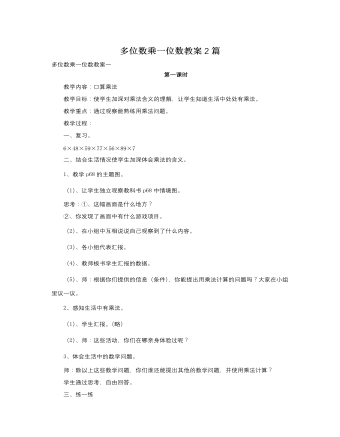
人教版新课标小学数学三年级上册多位数乘一位数教案2篇
教学内容:口算乘法教学目标:使学生加深对乘法含义的理解,让学生知道生活中处处有乘法。教学重点:通过观察能熟练用乘法问题。教学过程:一、复习。6×48×59×77×56×89×7二、结合生活情况使学生加深体会乘法的含义。1、教学p68的主题图。(1)、让学生独立观察教科书p68中情境图。思考:①、这幅画面是什么地方?②、你发现了画面中有什么游戏项目。(2)、在小组中互相说说自己观察到了什么内容。(3)、各小组代表汇报。(4)、教师板书学生汇报的数据。(5)、师:根据你们提供的信息(条件),你能提出用乘法计算的问题吗?大家在小组里议一议。2、感知生活中有乘法。(1)、学生汇报。(略)(2)、师:这些活动,你们在哪亲身体验过呢?3、体会生活中的数学问题。师:除以上这些数学问题,你们谁还能提出其他的数学问题,并使用乘法计算?学生通过思考,自由回答。

人教版新课标小学数学一年级下册位置教案2篇
1、找一找 (计算机演示图意)2、师:星期天,小江想到小明家去玩,可他只记得小明家住在三楼的左边,你们能告诉他小明家住几号房吗?(展开讨论,计算机学示结果)2、想一想师:我跟大家面对面地站着(老师举起右手),请问:老师举起的是右手吗?师:(老师把右手放下)请小朋友把右手举起来再判定一下老师举起的是不是右手。(老师又举起右手)学生讨论老师举着右手转身与学生同向,证实结论。师:我们面对面地站着,因为方向相对,举的右手就会刚好相反。练习:老师和学生一同举左手体验。四、 解决问题,增强应用意识1、说一说:你相邻的同桌都有谁?问:相邻是什么意思?面对黑板说说你相邻的同学有谁?背对黑板说说你相邻的同学有谁?侧转身再说说你相邻的同学有谁?师:每转一次前、后、左、右的人都发生了变化,但相邻的同学总是这几个。2、用电脑演示同学们上下楼梯的情景
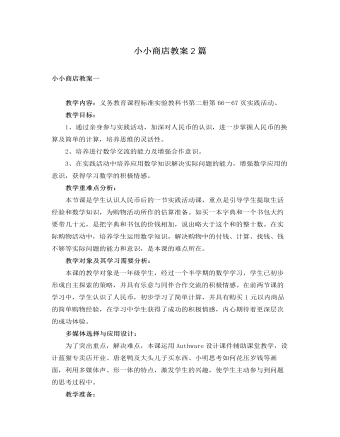
人教版新课标小学数学一年级下册小小商店教案2篇
3、同学们,你们看今天老师带来了什么?(出示一个学生喜欢的玩具)这是昨天老师去商店时买的,猜猜看,这个需要多少钱?(学生猜,教师可提示,最后得出正确标价)今天我们也来开个小小商店玩一玩买卖商品的游戏,想玩吗?4、选营业员及经理。我觉得当营业员最重要的是精通业务,计算能力强。谁想来当?(等学生举手后,教师选出4人。)考虑到我们呆会儿买的人会比较多,每个柜台一个营业员忙不过来,我还准备再选4名商店经理,做好以下几项工作:1)做好接待服务工作,顾客有困难能主动帮助。2)做好买卖过程中的组织工作,让大家有秩序地买商品。3)当营业员计算碰到困难时,两人能商量着解决。觉得自己能做到以上三点的同学可举手参加竞选。(学生举手后,选出4名经理)
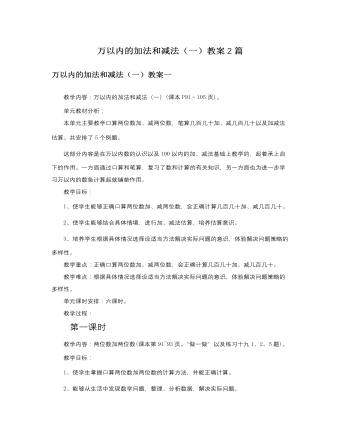
人教版新课标小学数学二年级下册万以内的加法和减法(一)教案2篇
3.小结。引导学生归纳两位数加减法的口算步骤:要把加上或减去的两位数看成一个整十数和一个一位数,先算两位数加、减整十数,再算两位数加减一位数。三、巩固练习课本第93页的做一做。分别指名口算,并说说怎么想的。四、全课总结1.根据学生回答,教师归纳小结并出示课题:口算两位数加、减两位数。2.口算两位数加、减两位数应注意什么?五、布置作业教后反思《标准》提倡算法多样化,目的是提倡学生个性化的学习。本单元仍然注意体现这一理念,如本课时教学口算两位数加、减两位数时,既呈现了口算方法,还出现了在脑中想竖式的方法;在教学笔算时,还出现口算的方法。其目的就是鼓励学生展开思路,在交流、比较的基础上不断地完善自己的想法,学习计算方法。
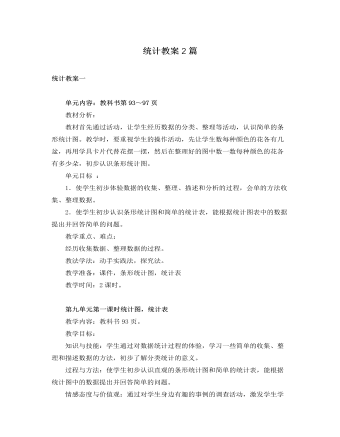
人教版新课标小学数学一年级下册统计教案2篇
2、揭题:小朋友们,知道吗?刚才你们的学习过程其实就是统计的过程,这节课我们就一起来研究统计的有关知识。3、发统计图和统计表:根据你刚才收集的数据,完成统计图和统计表。实践活动(调查全班小朋友们喜欢的动物)统计表:(学具卡片)绿孔雀非洲象大熊猫袋鼠梅花鹿河马统计图:(学具卡片)绿孔雀非洲象大熊猫袋鼠梅花鹿河马4、出示统计图和统计表。(1)通过小朋友们的统计,你能发现什么?(2)你可以提出什么问题?三、总结:1、日常生活中有许多事情可以用统计解决,你能说一说吗?2、谈谈这节课你的收获。作业布置:第二课时、练习教学内容:完成练习十七的2——4题。教学目标:巩固本单元所学的内容。教学过程:一、检查作业:1、小组互相交流自己调查的结果。2、展示几份。二、练习:练习十七1、第2题。(1)看图,明确题意。(2)先用自己喜欢的方法统计。(3)完成统计表及问题。(4)集体订正。
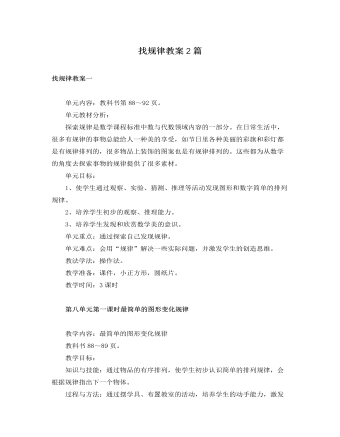
人教版新课标小学数学一年级下册找规律教案2篇
教学内容:教科书91页。教学目标:1、使学生通过观察、实验、猜测、推理等活动发现数字简单的排列规律。2、培养学生初步的观察、推理能力。3、培养学生发现和欣赏数学美的意识。教学重点:通过探索自己发现规律教学难点:会用“规律”解决一些实际问题,并激发学生的创造思维。教学过程:一、揭题:小朋友们,上节课我们不仅探索了有关图形的规律,而且还探索了有关数字的规律,这节课我们继续来学习。二、探索新知:1、学习例7。(1)小组合作学习例7,你们能发现什么规律?(2)学生小组活动。(3)汇报交流:第1组都是加1,第2组都是加2,第三组也是加2。2、学习例8。(1)小组合作学习例7,你们能发现什么规律?(2)学生小组活动。(3)汇报交流:第1组都是加5,第2组都是加3。三、完成做一做。四、学生创造性地思考其他有规律的数字排列。五、总结:通过这节课的学习,你有什么收获?作业布置:
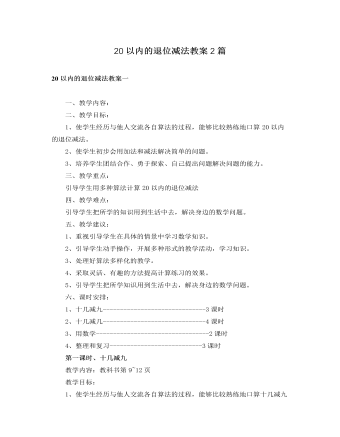
人教版新课标小学数学一年级下册20以内的退位减法教案2篇
一、揭题:小朋友们,今天我们一起来做练习。二、练习:1、第8题:这是一道计算题。(1)明确要求:看谁算得又对又快。(2)学生独立完成。(3)订正答案。(4)有错的学生,说一说计算顺序是怎样的,每一步的计算结果是多少?2、第9题:这是一道用数学的题。(1)看图,同位两个互相说说图意,并提出数学问题。(2)根据问题列算式解答。(3)订正答案。3、第10题:比一比。(1)明确要求,看谁先夺得红旗。(2)各小组派代表参加比赛。(3)对算得又对又快的学生提出表扬,并奖励给一个小标志。(4)再加入几组比赛题,尽量让学生多参与。4、第11题:这是一道用数学的题。(1)看图,说图意,提出数学问题。(2)列算式解答,指名板演订正。(3)说一说为什么用加法计算?5、思考题:小组讨论完成。一共12人,每两人之间插入一个女生,一共能插入11人。

